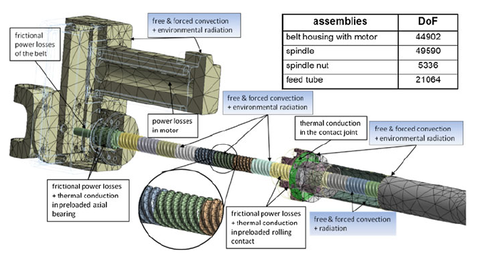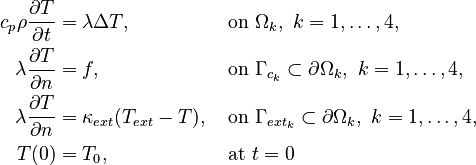Vettermann (talk | contribs) m (numbered headings) |
Vettermann (talk | contribs) m (minor edit) |
||
| Line 20: | Line 20: | ||
==Description== |
==Description== |
||
| + | |||
| ⚫ | |||
| ⚫ | |||
| ⚫ | |||
The mobile demonstrator-machine '''MiniHex''' consists of six struts of variable length, which are driven by ball screws, each with a servo-motor <ref name="grossmann2015"/>. Following one of the feedaxes is considered. It is divided into four stationary |
The mobile demonstrator-machine '''MiniHex''' consists of six struts of variable length, which are driven by ball screws, each with a servo-motor <ref name="grossmann2015"/>. Following one of the feedaxes is considered. It is divided into four stationary |
||
| Line 111: | Line 115: | ||
are divided into smaller parts and the average temperature of these parts is used for computing the input <math> u(t) </math>. To be more precise, the spindle is divided into 32 parts and the feed tube into 17 parts <ref name="galant2016"/>. |
are divided into smaller parts and the average temperature of these parts is used for computing the input <math> u(t) </math>. To be more precise, the spindle is divided into 32 parts and the feed tube into 17 parts <ref name="galant2016"/>. |
||
In the simulation the calculated average temperature of an area in the current time step serves as input temperature of this area in the next time step and is also used for calculating the thermally dependent |
In the simulation the calculated average temperature of an area in the current time step serves as input temperature of this area in the next time step and is also used for calculating the thermally dependent |
||
| − | heat transfer coefficients. Thus the average temperatures of all contact areas are needed as outputs <math> y(t) </math>. Further, the |
+ | heat transfer coefficients. Thus the average temperatures of all contact areas are needed as outputs <math> y(t) </math>. Further, the temperatures in certain nodes of interest complete the output <math> y(t) </math>. |
For more information concerning MOR for systems with moving loads see e.g. <ref name="lang2014"/> and the references therein. |
For more information concerning MOR for systems with moving loads see e.g. <ref name="lang2014"/> and the references therein. |
||
| + | |||
| ⚫ | |||
| ⚫ | |||
| ⚫ | |||
==Data== |
==Data== |
||
| Line 127: | Line 129: | ||
==Origin== |
==Origin== |
||
| − | The '''MiniHex''' is used as a demonstrator in the CRC/TR 96 financed by the German Research Foundation DFG. |
+ | The '''MiniHex''' is used as a demonstrator in the [https://morwiki.mpi-magdeburg.mpg.de/morwiki/index.php/Category:CRC-TR-96 CRC/TR 96] Project-ID 174223256 financed by the German Research Foundation DFG. |
==References== |
==References== |
||
| Line 144: | Line 146: | ||
<ref name="lang2014"> |
<ref name="lang2014"> |
||
| − | N. Lang, J. Saak and P. Benner, "Model Order Reduction for Systems with Moving Loads", at-Automatisierungstechnik, 8/2014, pp. 512–522. |
+ | N. Lang, J. Saak and P. Benner, "<span class="plainlinks">[https://doi.org/10.1515/auto-2014-1095 Model Order Reduction for Systems with Moving Loads]</span>", at-Automatisierungstechnik, 8/2014, pp. 512–522. |
</ref> |
</ref> |
||
</references> |
</references> |
||
Revision as of 11:33, 1 June 2023
 Note: This page has not been verified by our editors.
Note: This page has not been verified by our editors.
1 Motivation
Due to the increasing interest in manufacturing accuracy without an additional energy demand for cooling, knowledge about the thermo-elastic behavior of entire machine tools becomes crucial. Methods to correct the thermally induced position error between the tool-center-point (TCP) and the workpiece in real-time are needed. Therefore reduced-order models that enable a fast simulation of entire machine tools are applied in the design and production process.
2 Description

The mobile demonstrator-machine MiniHex consists of six struts of variable length, which are driven by ball screws, each with a servo-motor [2]. Following one of the feedaxes is considered. It is divided into four stationary subassemblies: belt housing with motor, spindle, spindle nut and feed tube. The thermal finite element (FE) model was generated in ANSYS and afterwards the FE system matrices were exported for post-proceessing, such as MOR, to MATLAB. The evolution of the temperature field is modelled with the heat equation
with
and

- number of the subassembly, 

- temperature 
- specific heat capacity 
- density 
- heat conductivity 
- domain of the k-th subassembly 
- contact boundary of the k-th subassembly (partly time varying, moves with the position of the nut) 
- heat transfer coefficient between a subassembly and the ambient air 
- external temperature 
- contact boundary with the ambience 
- friction driven heat flow induced by the movement 
- heat transfer coefficient between two subassemblies 
- temperature of the contact area of subassembly k.
The finite element discretization of the heat conduction models leads to the four systems
with

- FE mass matrix 
- basic stiffness matrix (discrete Laplacian) 
- number of boundary conditions with the ambience (Robin boundary conditions (RBC)) 
- boundary mass matrix (part of stiffness matrix arising from RBC) 
- state vector (discrete temperature) 
- input map 
- input vector 
- output vector 
- output map.
The interaction between the subassemblies is considered as position-dependent heat flows in the input  . The movement of the MiniHex is characterized by the position
. The movement of the MiniHex is characterized by the position  of the nut on the spindle with
of the nut on the spindle with
![d \in [-0.26,0.26]\text{ }m](/morwiki/images/math/8/5/3/853f9cde39cb1b243f7b2d054d2292b1.png) . This movement induces a variability of the contact areas between the subassemblies. To include this variability in the model the boundaries of the subassemblies
are divided into smaller parts and the average temperature of these parts is used for computing the input
. This movement induces a variability of the contact areas between the subassemblies. To include this variability in the model the boundaries of the subassemblies
are divided into smaller parts and the average temperature of these parts is used for computing the input  . To be more precise, the spindle is divided into 32 parts and the feed tube into 17 parts [3].
In the simulation the calculated average temperature of an area in the current time step serves as input temperature of this area in the next time step and is also used for calculating the thermally dependent
heat transfer coefficients. Thus the average temperatures of all contact areas are needed as outputs
. To be more precise, the spindle is divided into 32 parts and the feed tube into 17 parts [3].
In the simulation the calculated average temperature of an area in the current time step serves as input temperature of this area in the next time step and is also used for calculating the thermally dependent
heat transfer coefficients. Thus the average temperatures of all contact areas are needed as outputs  . Further, the temperatures in certain nodes of interest complete the output
. Further, the temperatures in certain nodes of interest complete the output  .
For more information concerning MOR for systems with moving loads see e.g. [4] and the references therein.
.
For more information concerning MOR for systems with moving loads see e.g. [4] and the references therein.
3 Data
The system matrices are given in the Matrix Market format and can be found in MiniHex.tar.gz. There is a set of matrices for each subassembly. The numbering of the subassemblies is as follows:
1 - belt housing with motor, 2 - spindle, 3 - spindle nut and 4 - feed tube.
Further the archive contains some MATLAB files with the description and computation of the 18 contacts between the
subassemblies as well as the computation of the temperature-dependent heat transfer coefficients. The overall system dimension is  with
with  ,
,  ,
,  and
and  .
.
4 Origin
The MiniHex is used as a demonstrator in the CRC/TR 96 Project-ID 174223256 financed by the German Research Foundation DFG.
5 References
- ↑ A. Galant, A. Mühl and K. Großmann, "Thermo-Elastic Simulation of Entire Machine Tool", in Thermo-energetic Design of Machine Tools, K. Großmann, ed., Springer International Publishing, Switzerland, 2015, pp. 69–84.
- ↑ K. Großmann, ed., "Thermo-energetic Design of Machine Tools", Springer International Publishing, Switzerland, 2015, pp. 9-10.
- ↑ A. Galant, S. Schroeder, B. Kauschinger and M. Beitelschmidt, "Erstellung und Abgleich eines strukturbasierten thermischen Modells der kugelgewindegetriebenen Vorschubachsen eines Hexapoden", in Thermo-Energetische Gestaltung von Werkzeugmaschinen, Tagungsband 4. Kolloquium zum SFB/TR 96, C. Brecher, ed., RWTH Aachen, Aachen, 2016, pp. 15–32.
- ↑ N. Lang, J. Saak and P. Benner, "Model Order Reduction for Systems with Moving Loads", at-Automatisierungstechnik, 8/2014, pp. 512–522.



